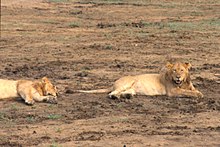Congo lion
| Congo lion | |
|---|---|

| |
| Male Congo lion in Murchison Falls | |

| |
| Congo lioness in Murchison Falls | |
| Scientific classification | |
| Domain: | Eukaryota |
| Kingdom: | Animalia |
| Phylum: | Chordata |
| Class: | Mammalia |
| Order: | Carnivora |
| Suborder: | Feliformia |
| Family: | Felidae |
| Subfamily: | Pantherinae |
| Genus: | Panthera |
| Species: | |
| Subspecies: | P. l. melanochaita
|
| Trinomial name | |
| Panthera leo melanochaita (Ch. H. Smith, 1842)
| |
| Synonyms | |
The Congo lion (Panthera leo melanochaita) is a lion population in Central Africa.[2][3] Formerly, it was recognized as a distinct subspecies under the scientific name Panthera leo azandica, which was considered native to the Democratic Republic of the Congo and western parts of Uganda. It was also known as the Uganda lion.[4][5]
Taxonomic history

The American zoologist Joel Asaph Allen proposed the trinomen Leo leo azandicus, and described a male lion as type specimen that was obtained by the American Museum of Natural History. This individual was killed in 1912 by museum staff as part of a zoological collection comprising 588 carnivore specimens. Allen admitted a close relationship to L. l. massaicus regarding cranial and dental characteristics but argued that his type specimen differed in pelage coloration.[6]
In 1913, Heller gave the taxonomic name Panthera leo nyanzae to lions in Uganda. In 1924, Allen gave the trinomen Panthera leo hollisteri to lions on the northern bank of Lake Victoria, before Ugandan lions were seen as being of the same subspecies as those in the northeastern part of the Democratic Republic of the Congo.[5]
The British taxonomist Pocock subordinated lions to the genus Panthera in 1930 when he wrote about Asian lions.[7] Three decades later, Ellerman and Morrison-Scott recognized just two lion subspecies, namely the African P. l. leo and the Asiatic lion P. l. persica.[8]
Since 2016, IUCN Red List assessors used the scientific name Panthera leo leo for lion populations in Northern, Western and Central Africa, which are genetically more closely related to each other than to lions in Eastern and Southern Africa.[9] This taxonomy was confirmed in 2017. Lions in Eastern Africa, including P. l. azandica, were subsumed to P. l. melanochaita.[2][3]
Distribution and population status

In the Congo River basin, Virunga National Park in the Democratic Republic of the Congo, and the adjacent Queen Elizabeth National Park in Uganda may be a potential stronghold for lions in Central Africa, if poaching is curbed and prey species recover.[10]
Lions are also present in Uganda's Kidepo Valley and Murchison Falls National Parks, in the Central African Republic, and in the south of Sudan.[11]
Threats and conservation
In Africa, lions are killed pre-emptively or in retaliation for preying on livestock. Populations are also threatened by depletion of prey base, loss and conversion of habitat. To address these threats, lion-human conflict needs to be reduced, and lion habitat and prey base increased. Since 1996, populations have been listed as Vulnerable on the IUCN Red List.[9]
In captivity
No captive individual of the Congo lion population is registered in the International Species Information System.[12]
See also
- Asiatic lion
- Barbary lion
- Cape lion
- Central African lion
- Ethiopian lion
- Masai lion
- Southwest African lion
- Transvaal lion
- Tsavo lion
- West African lion
References
- ^ Wozencraft, W. C. (2005). "Order Carnivora". In Wilson, D. E.; Reeder, D. M. (eds.). Mammal Species of the World: A Taxonomic and Geographic Reference (3rd ed.). Johns Hopkins University Press. p. 546. ISBN 978-0-8018-8221-0. OCLC 62265494.
- ^ a b "A revised taxonomy of the Felidae: The final report of the Cat Classification Task Force of the IUCN Cat Specialist Group" (PDF). Cat News. Special Issue 11: 76. 2017.
{{cite journal}}: Unknown parameter|authors=ignored (help) - ^ a b Bertola, L.D., Jongbloed, H., Van Der Gaag, K.J., De Knijff, P., Yamaguchi, N., Hooghiemstra, H., Bauer, H., Henschel, P., White, P.A., Driscoll, C.A. and Tende, T. (2016). Phylogeographic patterns in Africa and High Resolution Delineation of genetic clades in the Lion (Panthera leo). Scientific reports 6: 30807.
- ^ Allen, G. M. (1939). A Checklist of African Mammals. Bulletin of the Museum of Comparative Zoology at Harvard College 83: 1–763.
- ^ a b Haas, S.K.; Hayssen, V.; Krausman, P.R. (2005). "Panthera leo" (PDF). Mammalian Species. 762: 1–11. doi:10.1644/1545-1410(2005)762[0001:PL]2.0.CO;2.
- ^ Allen, J. A. (1924). Carnivora Collected By The American Museum Congo Expedition. Bulletin of the American Museum of Natural History 47: 73–281.
- ^ Pocock, R. I. (1930). The lions of Asia. Journal of the Bombay Natural Historical Society 34: 638–665.
- ^ Ellerman, J. R., and T. C. S. Morrison-Scott. (1966). Checklist of Palaearctic and Indian Mammals 1758 to 1946. Second edition. British Museum (Natural History), London.
- ^ a b Template:IUCN
- ^ Treves, A., Plumptre, A. J., Hunter, L. T., & Ziwa, J. (2009). Identifying a potential lion Panthera leo stronghold in Queen Elizabeth National Park, Uganda, and Parc National Des Virunga, Democratic Republic of Congo. Oryx 43 (01): 60–66.
- ^ Bauer, H.; Van Der Merwe, S. (2004). "Inventory of free-ranging lions Panthera leo in Africa". Oryx. 38 (1): 26–31. doi:10.1017/S0030605304000055.
- ^ Barnett, R., Yamaguchi, N., Barnes, I., Cooper, A. (2006). The origin, current diversity and future conservation of the modern lion (Panthera leo). Proceedings of the Royal Society B 273 (1598): 2119–2125. doi:10.1098/rspb.2006.3555 PMID 16901830
